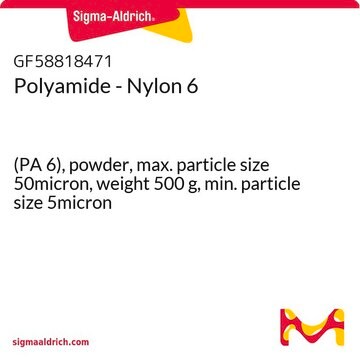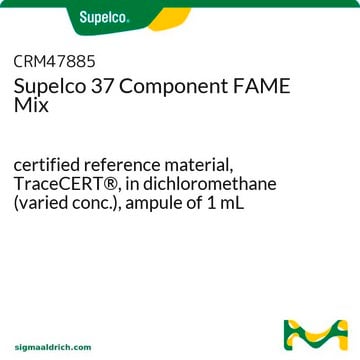The purity of this product can be roughly calculated from the phosphorus content (on a dried basis) and the sodium number provided on the Certificate of Analysis (COA). The minimum specification for purity is > 79% on a dried basis. To prepare a stock solution of this product, it is suggested to dry the product (e.g. 100°C overnight) to thoroughly remove the water of hydration, then accurately weigh the desired amount of the dried phytic acid sodium salt, then add a specific volume of distilled or deionized water to the weighed compound, finally stir the solution until the phytic acid sodium salt is completely dissolved.
P8810
Phytic acid sodium salt hydrate
from rice
Synonyme(s) :
Inositol hexakisphosphate, InsP6
Sélectionner une taille de conditionnement
59,30 €
Sélectionner une taille de conditionnement
About This Item
59,30 €
Produits recommandés
Source biologique
rice
Forme
powder
Composition
Sodium (Na), ≥5 mol/mol
Solubilité
water: soluble
Traces de cations
Ca: ≤2%
Température de stockage
room temp
Chaîne SMILES
[Na+].[Na+].[Na+].[Na+].[Na+].[Na+].[Na+].[Na+].[Na+].[Na+].[Na+].[Na+].[O-]P([O-])(=O)O[C@H]1[C@H](OP([O-])([O-])=O)[C@H](OP([O-])([O-])=O)[C@H](OP([O-])([O-])=O)[C@@H](OP([O-])([O-])=O)[C@@H]1OP([O-])([O-])=O
InChI
1S/C6H18O24P6.12Na/c7-31(8,9)25-1-2(26-32(10,11)12)4(28-34(16,17)18)6(30-36(22,23)24)5(29-35(19,20)21)3(1)27-33(13,14)15;;;;;;;;;;;;/h1-6H,(H2,7,8,9)(H2,10,11,12)(H2,13,14,15)(H2,16,17,18)(H2,19,20,21)(H2,22,23,24);;;;;;;;;;;;/q;12*+1/p-12
Clé InChI
KETSPIPODMGOEJ-UHFFFAOYSA-B
Vous recherchez des produits similaires ? Visite Guide de comparaison des produits
Description générale
Application
Actions biochimiques/physiologiques
Remarque sur l'analyse
Autres remarques
Code de la classe de stockage
13 - Non Combustible Solids
Classe de danger pour l'eau (WGK)
WGK 3
Point d'éclair (°F)
Not applicable
Point d'éclair (°C)
Not applicable
Équipement de protection individuelle
Eyeshields, Gloves, type N95 (US)
Faites votre choix parmi les versions les plus récentes :
Certificats d'analyse (COA)
Vous ne trouvez pas la bonne version ?
Si vous avez besoin d'une version particulière, vous pouvez rechercher un certificat spécifique par le numéro de lot.
Déjà en possession de ce produit ?
Retrouvez la documentation relative aux produits que vous avez récemment achetés dans la Bibliothèque de documents.
-
What is the purity percent of phytic acid sodium salt hydrate P8810? How to make stock solution using this?
1 answer-
Helpful?
-
-
How is shipping temperature determined? And how is it related to the product storage temperature?
1 answer-
Products may be shipped at a different temperature than the recommended long-term storage temperature. If the product quality is sensitive to short-term exposure to conditions other than the recommended long-term storage, it will be shipped on wet or dry-ice. If the product quality is NOT affected by short-term exposure to conditions other than the recommended long-term storage, it will be shipped at ambient temperature. As shipping routes are configured for minimum transit times, shipping at ambient temperature helps control shipping costs for our customers. For more information, please refer to the Storage and Transport Conditions document: https://www.sigmaaldrich.com/deepweb/assets/sigmaaldrich/marketing/global/documents/316/622/storage-transport-conditions-mk.pdf
Helpful?
-
-
How can I determine the shelf life / expiration / retest date of this product?
1 answer-
If this product has an expiration or retest date, it will be shown on the Certificate of Analysis (COA, CofA). If there is no retest or expiration date listed on the product's COA, we do not have suitable stability data to determine a shelf life. For these products, the only date on the COA will be the release date; a retest, expiration, or use-by-date will not be displayed.
For all products, we recommend handling per defined conditions as printed in our product literature and website product descriptions. We recommend that products should be routinely inspected by customers to ensure they perform as expected.
For products without retest or expiration dates, our standard warranty of 1 year from the date of shipment is applicable.
For more information, please refer to the Product Dating Information document: https://www.sigmaaldrich.com/deepweb/assets/sigmaaldrich/marketing/global/documents/449/386/product-dating-information-mk.pdfHelpful?
-
-
Hi, I have sodium phytate (lot: BCCF1452). In COA there is a result about phosphorus 22,2% (dried basis). What is that mean? Is that inorganic phosphorus content? If it is not, how can i calculate the inorganic phosphorus content?
1 answer-
The phosphorus value reported in the product Certificate of Analysis is the total amount. Currently, the inorganic phosphorus is not measured. However, historical data indicates that inorganic phosphorus levels are typically < 0.6 %.
Helpful?
-
Active Filters
Notre équipe de scientifiques dispose d'une expérience dans tous les secteurs de la recherche, notamment en sciences de la vie, science des matériaux, synthèse chimique, chromatographie, analyse et dans de nombreux autres domaines..
Contacter notre Service technique








